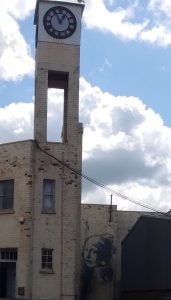This Week’s Bit of String: A beloved chicken farmer
In a small New Hampshire town during the 80s, graffiti appeared on a slab of roadside rock: ‘CHICKEN FARMER, I LOVE YOU.’ Legend has it, the message was directed at a girl living on the small chicken farm across the street, from a shy boy perhaps in her class.
About twenty years later, a revised message, similarly handpainted, appeared: ‘CHICKEN FARMER, I STILL LOVE YOU.’
Awww, you know? Awww. The story appears here in Atlas Obscura, and the entry describes the message as ‘a less personal but more public way of reaching out…’
The paradox of personal and public is an intriguing aspect of graffiti and street art. And that paradox affects us as writers too, essentially in reverse. Street artists preserve their anonymity but bring their work right in front of everyone; as authors we (assuming we don’t use a pen name) give up our anonymity but depend on readers’ choice as to whether our work gets seen or not.
So what can writers learn from street art and graffiti?
Resourcefulness
Some of my favourite examples of street art select a feature of the urban landscape and create a whole work around it. A couple pieces from Bristol:


It’s sort of an artist’s form of gathering bits of string, you might say, and I’m a big fan.
What a Difference a Letter Makes
In high school in the late 90s, I was tickled by a revised carving on a classroom desk. Someone had cut ‘MANSON FOREVER’ onto the surface, but someone else had mocked it by transforming it with a simple scratch into ‘HANSON FOREVER.’ Doesn’t sound quite so badass does it?
As a TA, I found some similarly misguided graffiti scratched on a table in a Science classroom: ‘Praise Satin.’
Typical of the devil’s insidiousness that his name would be easily conflated with a luxurious fabric.
Now, these entries aren’t art, according to any definitions discussed in earlier blog posts. But I do find them entertaining, and as writers we appreciate the importance of words—these silly ones remind us how essential each letter actually is.
Community Engagement

In Detroit, as in more and more cities around the world, there’s an annual Street Art Festival during which many different artists are given their own wall, each, to work on. Some use it to commemorate important figures of the area, to express the pain of the Black Lives Matter movement, or to remind citizens of vanished neighbourhoods. In this Huffington Post piece, Festival director Roula David describes their aims: to be ‘significant for the community as opposed to just putting pretty things on pretty buildings.’
In Belfast, murals honour many of the victims killed there during the Troubles. I learned about this thanks to a great post on Sandy Bennett-Haber’s blog. She refers to street art as a conversation between artist and environment, and also ‘a broad conglomeration of stories about and on the streets.’ Of course, I like this reminder that there are stories behind each work and its artist.
Even the kid carving ‘Praise Satin’ into a table has a story, possibly a rather interesting or disturbing one.
Breaking the Rules
Street art and graffiti give people who might otherwise feel ignored—young people, sometimes minorities, possibly lower socioeconomic status—a voice in their community. Using that voice is often an act of rebellion, of courage, and as writers we can emulate that.
Even while there are more and more street art festivals, many artists feel the best, most striking work is done unsupervised and perhaps illegally. Perhaps that’s because the most important things are worth fighting for. Especially these days, when the spectre of censorship looms, we writers should take heart at that.
For more stories about the role graffiti and street art play around the world, check out this feature on The Nature of Cities. Are there any special works of unconventional art near you? What’s the story behind them?